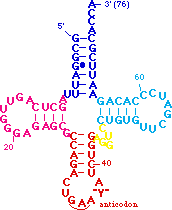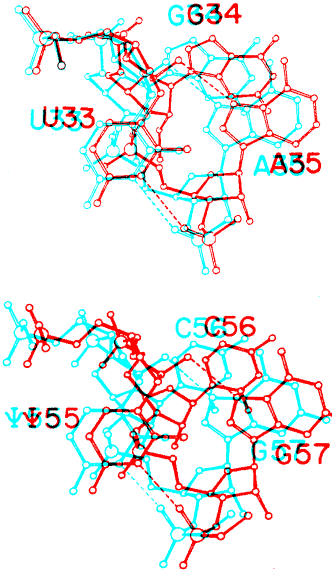Transfer RNA
Reference: Quigley, G. J. and A. Rich. (1976).
Structural domains of transfer RNA molecules. Science. 194,
796-806. [Medline Abstract]
I. Domains
tRNA Secondary Structure

Click here <
The acceptor stem includes
the 5' and 3' ends of the tRNA. The 5' end is generated by RNase
P :-). The 3' end is the site which is charged with amino acids
for translation. Some aminoacyl tRNA synthetases interact with
both the acceptor 3' end and
the anticodon when charging
tRNAs. Note how far the 3' end is from the anticodon
loop, at bottom, by clicking here <
II. Core Tertiary Interactions
Click the tertiary color button
here <
The green residues
are a reverse Hoogsteen pair between U8
and A14. This pairing is important
for positioning of the D stem relative to the stacked T
and acceptor stems.
The cyan residues
are a base triple in which A9
H-bonds in the major groove to A23
(which is paired with U12).
It stabilizes a sharp turn between bases 9 and 10.
The red residues
are a base triple in which 7-methyl-G46
from the variable loop H-bonds to the G22-C13
base pair of the D stem. This helps dock the variable
loop onto the D-stem.
A9 is also involved in
another type of tertiary interaction: it is intercalated between
bases 7-methyl-G46 and G45
<
II. U-turns

The conserved U-turn motifs are responsible for turns in
the anticodon and T loops <
The U-turn motif is repeated in the "T-loop"
of tRNA. This button zooms in on the T
U-turn <> (zoom
T). Residues 55-57
form the U-turn here. Take a look at the red/blue stereo picture of the anticodon and T-loop U-turns.
A U-turn is also found in the active site of the hammerhead ribozyme.
 Back
to intro to DNA-RNA structure.
Back
to intro to DNA-RNA structure.
Comments or Suggestions to:Jim
Nolan

![]() Back
to intro to DNA-RNA structure.
Back
to intro to DNA-RNA structure.